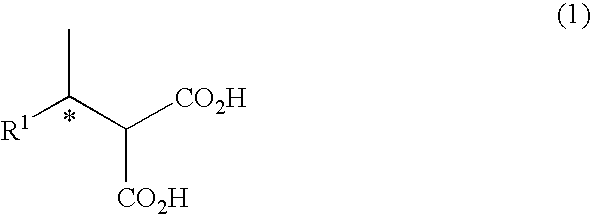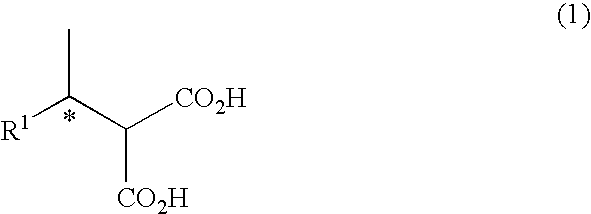Method For Producing Alcohol and Carboxylic Acid Having Optical Activity
a technology of optical activity and carboxylic acid, which is applied in the preparation of sulfonic acid esters, carboxylic compound preparations, organic chemistry, etc., can solve the problems of unsatisfactory optical purity or production level of a product, low yield, and method problems, etc., to achieve high optical purity, cheap and efficient production, and industrially simple and inexpensive effects
- Summary
- Abstract
- Description
- Claims
- Application Information
AI Technical Summary
Benefits of technology
Problems solved by technology
Method used
Image
Examples
example a
Production of Alcohol Having Optical Activity, Using Microorganisms
[0188](1) Isolation of microorganisms generating (S)-2-pentanol from 2-pentanone and microorganisms generating (S)-2-hexanol from 2-hexanone
[0189]Each of various types of cell strains shown in Table 1 was inoculated in 2.5 ml of liquid medium consisting of 5 g / L yeast extract (manufactured by Difco), 5 g / L POLYPPTONE(manufactured by Nihon Pharmaceutical Co., Ltd.), 3 g / L malt extract (manufactured by Difco), and 20 g / L glucose (manufactured by Nihon Shokuhin Kako Co., Ltd.). It was then aerobically cultured at 30° C. for 24 to 72 hours. 1 ml each of a culture solution was collected from each of the obtained culture solutions, and a cell mass was then collected by centrifugation. Thereafter, 0.04 ml of a Tris-HCl buffer solution (pH 7.0) and 0.028 ml of desalted water were added to the collected cell mass, so that the cell mass was sufficiently suspended therein. Thereafter, 0.05 ml of 100 g / L glucose and 0.02 ml of 1...
example b
Production of Optically Active Carboxylic Acid by Chemical Synthesis
example 1
Synthesis of (S)-2-methanesulfonyloxy pentane
[0243]4.14 g (47.0 mmol, 99.1% ee) of (S)-2-pentanol, 9.8 ml (71 mmol) of triethylamine, and 41 ml of dichloromethane were added to a 200-ml three-neck flask. The mixed solution was cooled on ice, and 4.36 ml (56.4 mmol) of methanesulfonyl chloride was then added dropwise thereto. Thereafter, the obtained mixture was stirred for 30 minutes. Thereafter, 40 ml of a saturated ammonium chloride aqueous solution and 20 ml of water were added to the reaction solution, and the reaction was terminated. The mixture was extracted with 80 ml of diethyl ether. An organic layer was then washed with 20 ml of a saturated ammonium chloride aqueous solution and 20 ml of brine, and was then dried with magnesium sulfate. The solvent was distilled away, so as to obtain 8.5 g of crude (S)-2-methanesulfonyloxy pentane. The obtained compound was used in the subsequent reaction without being purified.
[0244]1H-NMR(400 MHz,CDCl3) δ0.95(t,J=7.2 Hz, 3H), 1.42(d,J=6....
PUM
| Property | Measurement | Unit |
|---|---|---|
| Fraction | aaaaa | aaaaa |
| Fraction | aaaaa | aaaaa |
| Mass | aaaaa | aaaaa |
Abstract
Description
Claims
Application Information
 Login to View More
Login to View More - R&D
- Intellectual Property
- Life Sciences
- Materials
- Tech Scout
- Unparalleled Data Quality
- Higher Quality Content
- 60% Fewer Hallucinations
Browse by: Latest US Patents, China's latest patents, Technical Efficacy Thesaurus, Application Domain, Technology Topic, Popular Technical Reports.
© 2025 PatSnap. All rights reserved.Legal|Privacy policy|Modern Slavery Act Transparency Statement|Sitemap|About US| Contact US: help@patsnap.com



